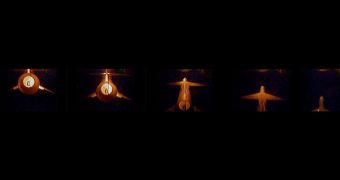Officials with the American space agency announce that their latest X-ray telescope was successfully deployed on its intended orbit yesterday, after taking off underneath the belly of a special airplane.
The Nuclear Spectroscopic Telescope Array (NuSTAR) mission is the first observatory of its kind that can be focused on particular targets. Its job will be to analyze high-energy phenomena in the Universe in the X-ray portion of the electromagnetic spectrum.
Some of its targets will include neutron stars, black holes, the Sun, active galactic nuclei and other similar structures. In addition, its datasets will be used to augment those provided by other missions.
The latter include the Hubble Space Telescope, the Spitzer Space telescope, the Chandra X-ray Observatory and the Fermi Gamma-ray Space Telescope. All of these spacecraft have been surveying the Universe from infrared to gamma-ray wavelengths (and everything in between) for many years.
NuSTAR was deployed to orbit by the payload fairing of a Pegasus XL rocket, which was provided to NASA by Orbital Sciences Corporation. OSC also provided the L-1011 Stargazer aircraft that took the delivery system high in the atmosphere on June 13, before releasing it at 9 am PDT (1700 GMT).
The Stargazer took off from the Kwajalein Atoll, in the central Pacific Ocean, one hour before launch. “We have been eagerly awaiting the launch of this novel X-ray observatory,” explains the director of the NASA Astrophysics Division, Paul Hertz.
“With its unprecedented spatial and spectral resolution to the previously poorly explored hard X-ray region of the electromagnetic spectrum, NuSTAR will open a new window on the Universe and will provide complementary data to NASA's larger missions,” he goes on to say.
One of the most important mission objectives for the newly launched telescope is to find and study the most energetic and active black holes in the Universe, as well as the supermassive dark behemoth that lurks at the core of the Milky Way.
According to the official mission log, Pegasus XL needed 13 minutes to reach its target orbit, and deploy the spacecraft. The first telemetry from NuSTAR was received at Mission Control through the agency's Tracking and Data Relay Satellite System (TDRSS), at 9:14 am PDT (1714 GMT).
“NuSTAR spread its solar panels to charge the spacecraft battery and then reported back to Earth of its good health. We are checking out the spacecraft now and are excited to tune into the high-energy X-ray sky,” explains Yunjin Kim.
The expert, who holds an appointment at the NASA Jet Propulsion Laboratory (JPL), in Pasadena, California, is the manager of the NuSTAR mission. The JPL manages the spacecraft for the NASA Science Mission Directorate, in Washington, DC.

 14 DAY TRIAL //
14 DAY TRIAL //